

The final showdown: 'Jungle' vs. Force
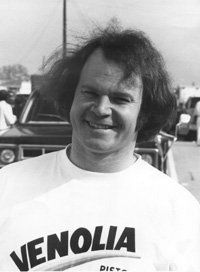 |
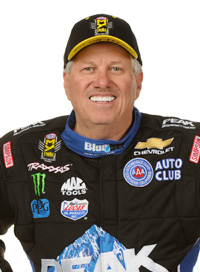 |
“Jungle Jim” or “Brute Force”? Nostalgic hero or modern-day legend? Vega or Firebird? Those are the questions that will be answered this weekend in Pomona when NHRA unveils the car atop the list of its yearlong fan vote among the top 20 Funny Cars of all time.
In one corner, “Jungle Jim” Liberman, a gypsy of the match race scene who rarely ran NHRA national events yet wowed fans with wild antics and a comely conspirator in “Jungle Pam” Hardy.
In the other corner, John Force, winner of an NHRA-record 147 national events and 16 championships, a fast-talking ex-trucker turned pursuer of Corporate America.
As I noted in a previous column, the fan votes are just as likely for the man as for any of his machines, though Liberman’s blue ’73 Chevy Vega, with the familiar “jungle man” swinging on a vine down its flanks, is as instantly recognizable and, on match race terms – be that wins or popularity – as successful as Force’s instantly recognizable green and white Castrol ‘96 Firebird that set and still holds a number of single-season class national event records.
So, who should get the nod? When I had Force all to myself in my office a few weeks ago, just two guys talking about drag racing, he humbly told me, “Maybe I’ll win, and maybe I won’t, and maybe I shouldn’t because he is the greatest of all time. I don’t base that on winning championships or finding money. I’d like to think I might win, but he ought to.” (You'll get the chance to vote for your choice at the end of this column.)
If we believe then that people are voting for the man or the machine, the question is obvious: What makes one greater than the other? Although the cars are as dissimilar as the two-decade link between them, it’s safe to say that Liberman and Force were cut from the same mold: up-from-nothing guys who were relentless self-promoters who garnered huge legions of fans with their personalities as much as their on-track activities and who loved “working the ropes,” as Force calls signing autographs.
Austin Coil, Force’s longtime crew chief and one of Liberman’s best friends, agreed that there “are an awful lot of similarities” between the two and that, given the chance, they’d be even more alike.
Showmanship
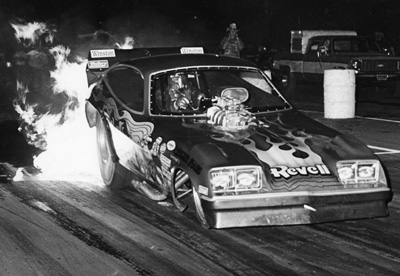 "Jungle" loved his fire burnouts |
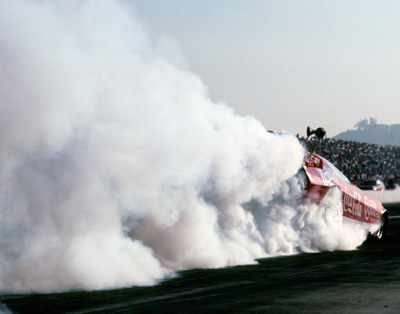 Rules prohibited Force from fire burnouts, but he could smoke 'em good. |
Obviously, you’ll never see Force arrive late to a race, fire up the Peak Chevy in the street, and drive it through the gates and onto the starting line as “Jungle” was known to do, and the last fire burnout Force did was probably when he kicked the rods out on a burnout, but that's just because things are a little more buttoned down, both in NHRA rules and corporate expectations. But what if … ?
“Let’s just say that everything that Jim did back then, John would do today if they’d let him,” Coil said. “The long burnouts have always been a part of John’s act, but I don’t think that NHRA would be too keen on fire burnouts.
“One thing about ‘Jungle’ was that he certainly was not fussy about details." he added. "When he drove my car once, the fact that all of the controls were in a different place than his car didn’t bother him a bit. Force likes to have his controls the same from car to car, but they both had plenty of natural talent.”
Longtime Liberman pal “Berserko Bob” Doerrer told NHRA National Dragster a few years ago that Liberman “had a way of making all of this look very spontaneous, and it drove the fans wild. But ‘Jungle’ had all of this very carefully planned with larger fuel and water tanks built into his car. There was a definite method to his madness.”
Although Force can’t get all wild and crazy on the racetrack, his P.T. Barnum-like skills are no less formidable. He’ll steal every spotlight – not by design, but by nature – just by being in the room. He never met a microphone or camera he didn’t love or a media member he couldn’t charm or at least disarm. He’s a gravitational force all of his own.
Mechanical aptitude
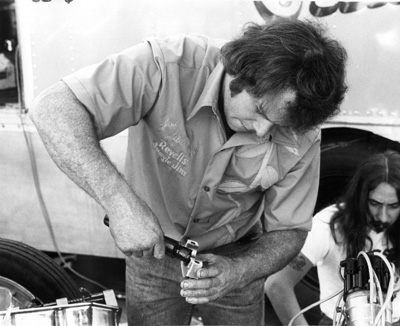 |
Probably the biggest difference between the two is that Liberman was a hands-on mechanic who tuned and serviced his own engines while Force has gained his success by hiring others to do that. It's not like Force doesn't know which end of the hammer to hit with -- he helped worked on his own cars for years in the start -- but his skills are best spent elsewhere.
Opined Coil, “John will be the first to tell you that he can’t work on a car, but I was amazed at what a fabulous, hardworking, and innovative mechanic Liberman was. He’d warm up the car all by himself without anybody sitting in it. He’d whack the throttle with the car sitting on jack stands, then walk around to make the necessary adjustments. He really was a one-man show. He once built a running race car from a pile of tubing in just 18 days, and he even did the lettering. He had tremendous talents with anything that could be done with his hands.”
“He had a real feel for everything mechanical,” recalled Hardy. “He was very innovative. [If he had lived longer] he probably would have come up with something that changed the direction of drag racing.”
Salesmanship
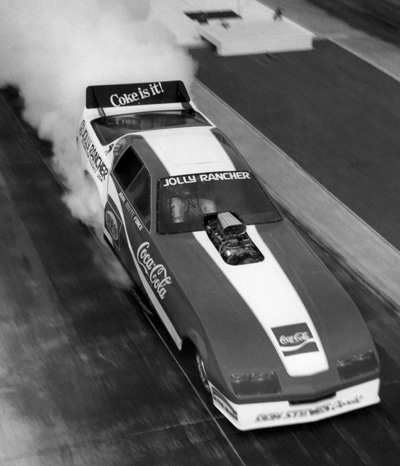 |
The ability to sell his act to track management notwithstanding, Liberman was not nearly the salesman that Force is, at least on the corporate side, but maybe that was his choosing. He answered to no one but himself and the number of dates he wanted to fill. Other than the Revell deal that first showed up on the Vega in question, Liberman had no other major backers (but lots of local support), but that might have changed had Liberman not met his end. It has been well-documented that Liberman was wooing 7-Eleven, and a number of insiders have told me that in going through “Jungle’s” effects after his passing, they found a letter from 7-Eleven expressing an interest in going forward with him. What could have been ...
“I think ‘Jungle’ knew how popular he was, but he wasn’t as committed as, say, ‘Snake’ and ‘Mongoose’ to the whole sponsorship thing,” recalled Hardy. “He just didn’t fit the corporate mold.”
Force, on the other hand, seldom met a CEO he couldn’t at least make laugh if not open a checkbook. From Leo's Stereo to Wendy's to Coca-Cola to Castrol to Peak and all of the deals for his drivers (Auto Club, Traxxas, Monster, et al), he knows how to land the big fish. His well-publicized troubles of a few years ago are a distant memory (though likely not forgotten). Force is the proverbial guy who could sell ice cubes to an Eskimo, but with a proven track record and with a work ethic such as he has – and that he instills in his drivers – to tirelessly and relentlessly service his sponsors and fans, he’s selling something way more desirable. He knows the game and plays it very well.
The drive
 In 2008, Force became the first NHRA driver to record 1,000 round-wins. Entering this weekend's event, it's up to 1,260. |
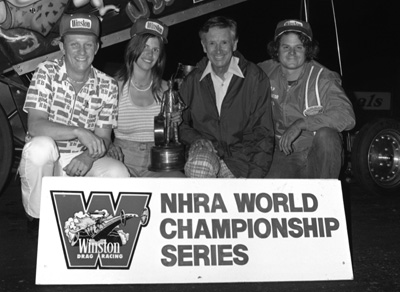 Jim Liberman's shining moment: a win at the 1975 Summernationals |
Force has to win, or it eats him up. He has to win on the track, in the boardroom, with his daughters, in the public perception – everywhere. He’ll hold team meetings, evangelize and proselytize, to rally his troops and supporters.
Even when he was on the verge of being mathematically eliminated from this year’s championship race, Force would have none of it. “I don’t care what the math says,” he said. “Until they tell me it’s impossible to win the championship, I am going to fight with everything that I have to win it. We won’t stop until we walk into the banquet and we know where we stand.”
Liberman didn’t much like to lose, either. Although he once said of his faster opponents, “I don’t have to beat them; I just have to put on a better show,” winning was still winning, losing still losing.
Recalls Hardy, “If ‘Jungle’ lost, you didn’t run up and talk to him – he was busy reviewing it in his mind – but he picked up the pieces and went to the next race. When he lost the final round at Englishtown in 1974, it was absolutely crushing. On the other hand, when he won the race the next year, he was walking on cloud nine. It was a vindication of his talents.”
Longevity
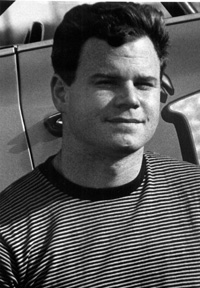 |
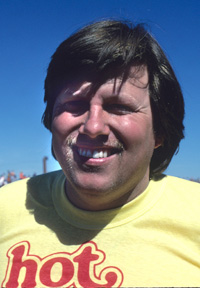 |
This is a tough one because Liberman’s career spanned just a dozen years, from his start in 1965 in the Hercules Nova to that fateful encounter with a bus in September of 1977, and who knows what the future might have held.
“He did mention that he wanted to quit driving and just build the engines,” Hardy told me. “He might have been seeing the big picture. He wasn’t a kid anymore; hell, he was almost 32 when he died. Remember: ‘Never trust anyone over 30.’ ”
Coil is sure that Liberman, who would be 72 now, would still be involved somehow if he were still alive.
“You have to remember that Liberman was almost 32 when he died,” he said. “John Force was probably a lot wilder at that age, too, but John has mellowed out over the years, and I think the same thing would’ve happened to ‘Jungle’ if he had lived.”
Force is 67 and has been racing Funny Cars for more than 40 of those years, and he’s still a proven winner. The end may be in sight – he hints at it all the time – but he’s not there yet by a long shot. His kids racing alongside him keeps him young, and winning and secure sponsorship don’t hurt, either. There’s no doubt he’ll top 150 wins before he’s done, and he'll probably win another championship.
So … who do you think will win? Vote now. (This poll will only stay open until the reveal on Saturday’s qualifying show from Pomona.)



















































